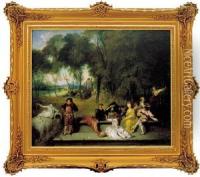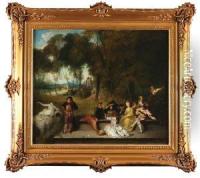Korneli Szlegel Paintings
Korneli Szlegel was a notable figure in the world of art, born in the year 1839 in Warsaw, then part of the Russian Empire, and passing away in 1902. His life spanned a period of significant change in Europe, witnessing the upheavals of national revolutions, the Industrial Revolution, and significant developments in the arts and culture. Szlegel's contributions to the art world were marked by his unique style and the diverse subjects he chose to depict, reflecting the broader movements of Romanticism and later, Realism, that dominated European art in the 19th century.
Szlegel was educated in the fine arts at some of the most prestigious institutions of his time, which was a common path for artists who later emerged as key figures in their respective fields. However, specific details about his education remain scarce, reflecting the limited documentation of many artists from this period. What is known is that Szlegel traveled extensively throughout Europe, drawing inspiration from various cultures and artistic movements. This exposure is evident in the eclectic nature of his work, which includes landscapes, portraits, and historical scenes.
Throughout his career, Szlegel's art was celebrated for its emotional depth and technical proficiency. His landscapes, often depicting his Polish homeland, are notable for their detailed realism and the mood they evoke, reflecting the artist's Romantic inclinations. His portraits, on the other hand, reveal a keen insight into character and social status, suggesting a realist approach to capturing the essence of his subjects.
Despite his talent and the breadth of his work, Korneli Szlegel did not achieve the same level of fame as some of his contemporaries. This may be attributed to various factors, including the political and social upheavals of his time, which impacted the art market and distribution. Nevertheless, his contributions to the art world have been reassessed over time, and he is now recognized as an important figure in the transition from Romanticism to Realism in European art.
Szlegel's legacy is preserved in the collections of several European museums, where his works continue to be studied and admired. His life and art offer valuable insights into the cultural and historical contexts of the 19th century, making him a subject of interest not only to art historians but to anyone fascinated by this pivotal era in European history.


